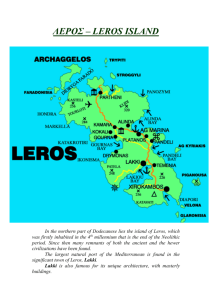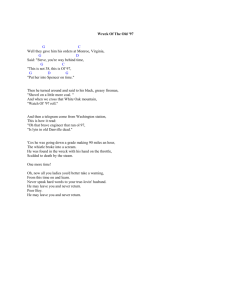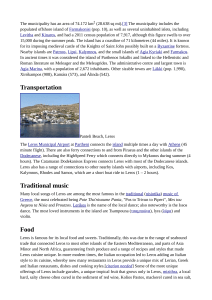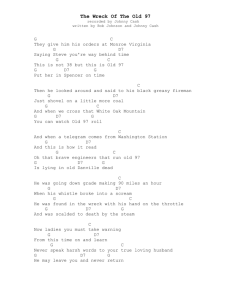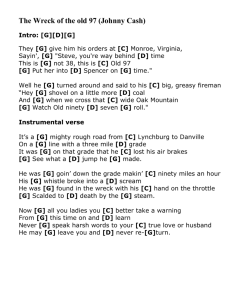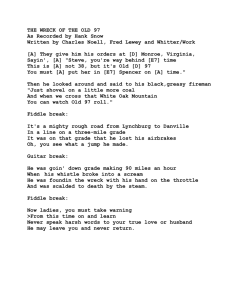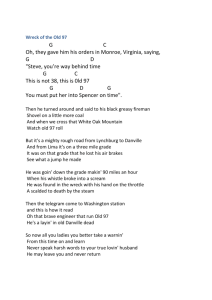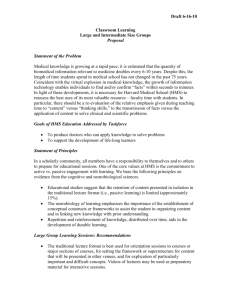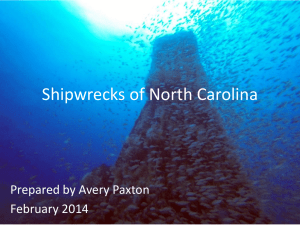2014 LEROS EBOOK final.
advertisement
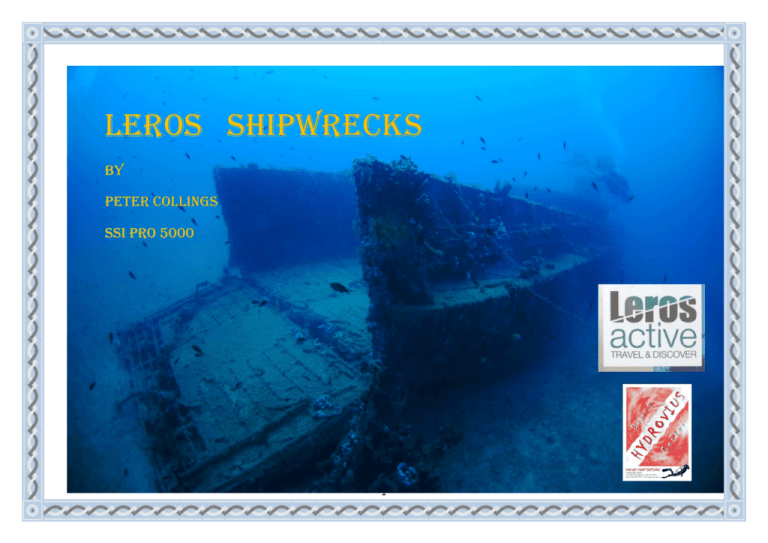
LEROS SHIPWRECKS BY PETER COLLINGS SSI PRO 5000 1 2 Λέρος Introduction Not for the first time I have been invited to new and exciting locations to research, identify and promote a collection of shipwrecks. The recent change of policy with Greek Archaeology sites has opened up many wreck sites throughout the Aegean and Leros is, I hope the first of many to come. If this island is unique in its atmosphere and culture, then so is its history, both above and below the surface of the warm clear waters of the Aegean. Nowhere else have I been able to dive on German, English, Greek and Italian war casualties in one area! In this title I have tried to encompass the spirit of the island, its lively yet somehow relaxed charm, while showcasing the rich history. WW2 for many is a fascinating subject and its events are so well documented throughout the island in public and private collections, monuments and museums, as well as the remains of the Battle of Leros - The Malta of the Aegean. Although the diving service of Kostas at Hydrovois Diving is very well established, I suspect that there are more treasures waiting to be found. Already the initial survey has shown up several targets and although some are deep, others may someday add to the list herein. I look forward to updating this, the 16th title in our E book series, with those new discoveries and hope that you the reader enjoy your journey through this historic Island, above and below the waves. 3 Acknowledgements Having travelled the world over several times, I can state without question that I have never been made more welcome or met more friendly and generous people than here on Leros. During my all- to- brief stay I have met so many people from all walks of life who made this venture so worthwhile and memorable. They hasten my return..... My special thanks go to; Carolina at Leros Active. Kostas at Hydrovious Dive. Apostolis Karpathakis at Psaropoula Taverna Pandeli. Dimitris Karpathakis at Taverna Patimenos, Pandeli. Fam.Mavraki at Taverna Alinda, Alinda.Dimitris Spyrou at To Steki, Alinda. Dina and Thanassis at Aquamarine, Alinda.Katerina Koumbarou at Chrissoula Hotel, Alinda. Ioannis Paraponiaris Deposito Di Guerra.Nikitas Koumbaros at Sun Rental. Nikos Francescos at Francescos Motorent. Anna and Kostas at Pizza House Broutzi. Marietta for the tour way up there! The E book concept The idea of the E-Book series came about after seeing so many incorrect publications quoting the wrong identity of the Tile Wreck at Abu Nuhas in the Egyptian Red Sea. Despite a plethora of undeniable facts presented by myself and members of the Red Sea Wreck Academy, self-proclaiming experts still, for reasons known only to them, continued to quote the Marcus as the Chrisoula K. It was archive photographs from Howard Rosenstein and the location of the ships bell, which added weight to Stephan Jablonski’s accounts of the sinkings’. This new material gave us enough to produce the first E-book in 2008.Being free from restrictions it soon found its way around the world and was passed on from diver to diver. It had the desired effect. Now more and more reports carry the correct identity. Sadly some don’t! It was also an opportunity to give something back to diving. Of course there was also controversy over the identity and purpose of the Russian Wreck at Zabagad, and this lead to the second title. “Thistlegorm Revealed” is a leader for the new publication “Sunderland To Suez -The Story Of The Thistlegorm”, out now. “Suez Wrecks” highlights the achievements of our regular wreck hunting trips up into the Gulf and “Egyptian Shipwrecks” gives a glimpse of the forthcoming book featuring over 200 wrecks in Egyptian waters. The demand for other area’s with a healthy collection of shipwrecks has lead to publications featuring Truk Lagoon, Maldives Malta , Coron and Palau. So now we have a total of 16 titles available, and more on the way, yours to enjoy and pass on to anyone who may be interested. Don’t forget we run regular expeditions and safaris to all these featured wrecks. Safe diving. Peter Collings. 4 CONTENTS INTRODUCTION THE ISLAND OF LEROS WRECK LOCATION MAP RHN VASILISSA OLGA LC 3 LANDING CRAFT ANTI SUB NET TENDER POINEER UNDBOOTE GERMAN LANDING CRAFT HEINKEL HE 111 German Bomber ARADO AR 196 Seaplane JUNKERS JU 88 German Bomber MOLCH (Salamander or Newt) ONE MAN MINI SUB HMS DULVERTON Destroyer HMS ECLIPSE HMS INTRPID HMS HURWORTH HMS TROOPER IRM EURO Destroyer DIVING SERVICES APRES DIVE MUSEUMS DINNING OUT page 3 page 7 page 6 page14 page 17 page 24 page 30 page 38 page 42 page 46 page 51 page 52 page 53 page 54 page 56 page 57 page 58 page 59 page 60 page 61 page 63 5 Queen Olga 6 Leros is a Greek island of the Dodecanese of the southern Aegean Sea. The island is 74 square kilometres (29 sq mi) and has a coastline of 71 km (44 mi). Nearby islands are Patmos, Lipsi, Kalymnos, and the small islets of Agia Kyriaki , Farmakos, Levitha and Kinaros, . It is known for its imposing medieval castle of the Knights of Saint John. The largest town is Agia Marina. 7 History After the Peloponnesian War Leros came under the sovereignty of the Spartans. The island had a famous sanctuary of the goddess Artemis. It then followed the fate of the rest of the Dodecanese Islands during the years of Alexander the Great and his successors, the Roman years and the Byzantine period. After the division of the Roman Empire, Leros was part of the Byzantine Empire. During the Byzantine Age, the island was incorporated into the Theme of Samos. During the thirteenth century, the island was occupied by the Genoese and then by the Venetians. In the year 1309, the Knights of St John seized and fortified Leros. In 1505, the Ottoman Admiral Kemal Reis, with three galleys and seventeen other warships, besieged the castle but could not capture it. The operation was repeated in 1508 with more ships, but again nothing was achieved. Finally, on 24 December 1522, following the siege of Rhodes, a treaty was signed between Sultan Suleiman and the Grand Master of the Knights, Philippe Villiers de L'Isle-Adam, and Leros, along with all the Aegean possessions of the Order, passed into Ottoman hands which ruled the island with brief interruptions during a period of four hundred years. During the Greek Revolution of 1821, the island was liberated and became an important base for the re-supplying of the Greek Navy. With the Treaty of London 1830 the islands were once again given over to the Ottoman Empire and under TurkishAdministration until 1912. In 1912, during the Libyan War against the Ottoman Empire, the Italians occupied all of the Dodecanese islands (except Kastelorizo). On May 12, 1912 the island was seized by the sailors of the Italian Navy cruiser "San Giorgio". The Greek inhabitants of the islands declared the autonomy of the islands under the title "The Aegean State", with the aim of unification with Greece, but with the outbreak of the First World War, these moves came to nothing, and the Italians retained control of the islands. From 1916 to 1918, the British used Leros as a naval base. In the Venizelos-Tittoni Agreement of 1919, the island was to be returned to Greece, along with all of the Dodecanese except Rhodes, but after the Greek defeat in the Greco-Turkish War the Italians cancelled the agreement. As a result the Treaty of Lausanne confirmed the Italian possession of Leros and the Dodecanese. During the 31 years that the Italians remained in Leros, they set up a great plan to build and fortify the island, since its strategic position and its large natural harbours (the largest of which, Lakki, is the largest deep water harbour in the Mediterranean Sea), made it an ideal naval base. The fortification of Leros and the creation of a major naval base at Lakki, ensured that the Italians had control over an area of vital interest to the Allies (the Aegean, the Dardanelles and the Near East). 8 From 1940, when Italy entered the Second World War on the side of Germany, Leros suffered bombing raids by the British Royal Air Force. As a result of the excellent anchorage provided to warships by the many natural coves, the island was the second most bombed during World War Two (after Crete). During Italian rule, Leros, with its excellent deep-water port of Lakki (Portolago), was transformed into a heavily-fortified aeronautical and naval base, "the Corregidor of the Mediterranean", as Mussolini boasted. The island was base for some Italian naval units, specifically: • • • 4ª squadriglia cacciatorpediniere (4th destroyer flotilla) with the sole destroyer Euro; III Flottiglia Mas (third MAS Flottilla) with two motor torpedo boats and six MAS; XXXIX Minesweeper Flottilla with eleven boats; Additional vessels included, seven steamships, two minelayers and three Marinefährprahm of German project. Motoscafo Armato Silurante (Italian: "Torpedo Armed Motorboat"), commonly abbreviated as MAS was a class of fast torpedo armed vessel used by the Regia Marina (the Royal Navy of Italy) MAS were essentially motorboats with displacements of 20–30 tonnes (depending on the class), a 10-man crew, and armament composed of two torpedoes, machine guns and occasionally a light gun. 9 After the fall of Greece in April 1941 and the Allied loss of the island of Crete in May, Greece and its many islands were occupied by German and Italian forces. With the surrender of Italy on 8 September 1943 however, the Greek islands, which were seen as strategically vital by Churchill, became reachable for the first time since the loss of Crete. On 8 September 1943, as Italy could not continue the war on the German side, it signed an armistice and came over to the Allied camp. After the Italian armistice, British reinforcements arrived on Leros and other Dodecanese islands and the island suffered continuous German aerial bombardment. 10 One of the largest attacks was on the Greek Navy's flagship, the Queen Olga, sunk by German bombers on Sunday September 26, 1943, along with HMS Intrepid, while they were anchored in Portolago. This signalled the start of ther Battle of Leros. It was to last for 52 days ending in operation Taifun. The island of Leros was finally captured by German troops during operation Taifun in airborne and amphibious assaults between 12–16 November 1943. The forces involved were paratrooper units and a battalion from the elite Brandenburg division. The ground troops were supported by bombers of the Luftwaffe. Among them I.and II. group of Stuka-Wing 3. I. Group operated from Megara Air Base. After the fall of Leros, which was received with shock by the British public, Samos and the other smaller islands were evacuated. The Germans bombed Samos with Stukas, prompting the 2,500-strong Italian garrison to surrender on 22 November. Along with the occupation of the smaller islands of Patmos, Fournoi and Ikaria on 18 November, the Germans thus completed their re-conquest of the Dodecanese, which they were to continue to hold until the end of the war. The Battle of Leros was considered by some to be the last great defeat of the British Army in World War II, and one of the last German victories. The German victory was predominantly due to their possession of complete air superiority, which caused great losses to the Allies, especially in ships, and enabled the Germans to supply and support their own forces effectively. The whole operation was criticised by many at the time as another useless "Gallipoli"-like disaster, and the blame was laid at Churchill's door. 11 The withdrawal of the American fighters had sealed the fate of Leros. With no air support and heavily attacked by enemy aircraft, the three battalions had fought for five days until they were exhausted and could fight no more. The Commander-in-Chief, Ninth Army, General Wilson, reported to the Prime Minister: "Leros has fallen, after a very gallant struggle against overwhelming air attack. It was a near thing between success and failure. Very little was needed to turn the scale in our favour and to bring off a triumph." Casualties; Approximately 520 GERMANS (300 PARATROOPERS), 187 ALLIES, 164 ITALIANS,68 GREEK OFFICERS & SAILORS FROM "VASSILISSA OLGA" & 20 CIVILIANS 12 51ST BOMBER WING EDELWIESS Much of the bombing of Leros can be attributed to the 51st bomber wing of the Luftwaffe. Stab/KG 51 and I./KG 51 were formed on 1 May 1939 at Landsberg am Lech, and the formation was completed on 20 August 1939. The units were initially designated KG 255. and equipped with the Dornier Do 17Ps, and later reequipped with Heinkel He 111Hs in August 1939. The unit spent most of the summer training and recruiting personnel from the flight schools, and the Geschwader did not see much action during the Polish Campaign. II./KG 51 was formed between 1 December 1939 and 15 April 1940. This Gruppen was equipped with the infamous Junkers Ju 88.- Bomber, pictured above. III./KG 51 was also formed during this time. Formation began on 1 September 1939 and was completed in May 1940. Based on Argos and later Rhodos, II. Group of Kampfgeschwader 51 with Ju 88 were available for air strikes due to their range. The Luftwaffe unleashed continuous attacks on Leros, enjoying complete air superiority, and caused many casualties among the ground forces and sank the British destroyer HMS Intrepid, the Greek destroyer Vasilissa Olga on 26 September, and the Italian destroyer Euro on 1 October. 13 THE WRECKS VASILISSA OLGA (D 15)- ΒΠ Βασίλισσα Όλγα 14 Built by Yarrow and Co in 1937, The Vasilissa Olga (D15) was completed by 1939 and was a modified G class destroyer. She was known as the Queen Olga. Her displacement was 1414 tons, she was fitted with 3 Yarrow drum boilers, and 2 Parsons turbines into Shafts: 2 (twin screw), Power: 34,000 hp She was 97 x 9.7 x 2.7, had a speed of 35 knots and a range of 480 miles She had a compliment of 145.Armament4×5 in, 1×4 21 in T/T, 1×3 in A/A, 6×20 mm A/A, A/S device added; Vasilissa Olga (Greek: ΒΠ Βασίλισσα Όλγα) was a Greek destroyer of the Vasilefs Georgios (modified G) class, which served with the Royal Hellenic Navy during the Second World War, becoming its most distinguished and successful ship until her loss in 1943. She was named after Queen Olga of Greece, the wife of King George I, and was the second ship to bear this name. Built by Yarrow & Company (Scotstoun, Scotland), along with her sister ship, the Vasilefs Georgios, she was the most modern ship of the Greek Navy at the outbreak of the Second World War. She participated in the naval operations of the Greco-Italian War, in convoy escort duty and in the first and third naval raids against Italian shipping in the Strait of Otranto (14–15 November 1940, and 4–5 January 1941). After the German invasion of Greece, along with several other ships, she escaped to Alexandria in May 1941. She was assigned the British pennant number H 84, and after undergoing modernization in Calcutta (November-December 1941), she returned to active duty in the Mediterranean Sea. Under her captain, Lt. Cmdr. G. Blessas, she enjoyed several successes: • • On December 14, 1942, she sank the Italian Adua-class submarine Uarsciek (620 tons) off Malta, along with the British destroyer HMS Petard.[1] On January 19, 1943, Olga, along with the British destroyers HMS Pakenham and HMS Nubian, intercepted and sank the Italian transport ship Stromboli (475 tons) off the Libyan coast. 15 • On June 2, 1943, Olga and the British destroyer HMS Jervis sank the Italian Spica class torpedo boat Castore (ca. 790 tons) off Cape Spartivento. Olga also participated in the capture of Pantelleria and the Allied invasion of Sicily. During the Allied operations during the Dodecanese Campaign in the Aegean Sea in September 1943, together with the British destroyers HMS Faulknor and Eclipse, she sank a German convoy, consisting of the transports Pluto (2,000 tons) and Paolo (4,000 tons), near Astypalea. During the Battle of Leros, she transported members of the Long Range Desert Group to the island, but on September 26, she was attacked and sunk by 25 Junkers Ju 88 bombers in the Gulf of Lakki in Leros. Cmdr. Blessas, 6 officers and 65 other members of the crew perished with the ship. A monument has been erected in Lakki in honour of the ship. THE WRECK TODAY There is now doubt that the wreck has been well dispersed. Several accounts of her salvage and indeed that of Intrepid and Euro abound. One recalls a company being contracted to raise the vessels and another was that “freelancers” set about stripping the wrecks. Whichever story is true Intrepid and Euro are no more and Olga is a veritable scrapyard. The most prominent section is what appears to be her bow, which is vertical, and stands a couple of metres proud of the seabed. Hence onward the wreckage is scattered over a wide area and consists of plates and piping. Occasionally a recognisable feature appears, such as the gun mountscircular cog tracks fore and aft, although it is difficult to distinguish the stern-the wreckage simply disappears into the sand. The entire wreck is criss crossed with fishing wire, and this makes any close up inspections difficult. Visibility is not crisp as with the wrecks outside of the harbour. Sea bed in the region of 36 metres and there are a few bream around the wreck. Because of its location in the harbour special permission has to be obtained to dive the wreck. . 16 LC3 LANDING CRAFT (LC923) (Higgins) Lying in a depth of 32 metres, close to Merika harbour is a completely intact landing craft. Although British in design, LC923, she was captured by the Germans at Alida and re coded as GD 05.One report states that she was scuttled after the war, but damage to her hull forward of the starboard aft deck would suggest she was sunk by shell fire. Developed from an original American design, this version had an armoured wheelhouse fitted above the engine, and was mainly used as a troop carrier during assault landings. They saw action throughout the Second World War. 17 The Higgins type LC3 Landing craft had a 10-foot (3.0 m) wide load area at the front and a small armoured (1/4 inch steel) wheelhouse on the aft decking over the engine room. It had a displacement: 52 tons (loaded); 23 tons (empty) • • • • • • Length: 50 feet (15 m) Beam: 14 feet (4.3 m) Draft: 3 feet (0.91 m) (forward); 4 feet (1.2 m) (aft) Speed: 8 knots (9.2 mph) (loaded); 11 knots (13 mph) (empty) Armament: two .50-cal M2 Browning machine guns Crew: 4 Sitting on a silty sea bed at a depth of 36 metres, the landing craft is upright and since her sinking the ramp has fallen forward. Under the ramp Groupers and bream in large numbers have made their home from this unnatural cave. Her small wheel house stands proud but her controls, like her propeller, are missing. The bulk head between the loading deck and the engine room has rotted away allowing access. The diesel engine sits on the port side. Many small Cardinal fish shelter in the interior. After exploring her engine it is possible to ascend up onto the aft deck. Much of the hull is intact except for the single shell hole. 18 The wreck is covered in a skin of yellow, orange and red concretion-sea squirts, plume worms and bryazones. Some beautiful nudibranchs live in the sea firs and there are the obligatory bristle or fire worms. Due to its small size it affords some excellent photo opportunities, especially with wide angle (16mm or less) lenses. The wreck is usually buoyed and visible from 20 metres. Little or no current exists around the wreck. 19 LC 3 Landing Craft Wheelhouse. Stern Engine room access. Hull covered in marine growth Cargo or troop deck Ramp in “down” position. Cave under ramp & keel. (much fish life) 20 Sand & silt 38 mtrs 21 A fascinating eco system can be found around the hull and keel of the landing craft. Many invertebrate species can be found including nudibranchs (left), fireworms of bristleworms (centre) and tube worms (right).Sponge bryazone, and seasquirts encrust the structure. ITALIAN CARGO SHIP (UNKNOWN) Another vessel which seems to have been completely removed. Reported to be an Italian cargo ship, what little remains can be found just off the jetty at Merikia in 34 mtrs. Scattered plates and a few pipes are all that remain. Wreckage sits no more than a meter off the sea bed, but does attract a good population of fish life BARGE WRECK Again of Italian Origin, this barge was used in the operation of the anti- submarine nets and can be found at the entrance of Lakki Bay at Aggistri. Lying flat on the sea bed, there is a flat platform with mooring cleats and winch gear, between the hull and sea bed there are many safe havens for fish and the hull is covered in coral growth (38-41m) 22 UNKNOWN WRECK SOUTH OF CAPE. During the recent survey of the waters around Leros, the sonar side scan revealed an as yet unidentified shipwreck lying in 60 metres of water. An exploratory dive is planned to learn more about this un-dived wreck, and research into its identity is ongoing. Given the amount of documentation available, a list of “suspects” can be drawn up, and conversely, many know casualties “eliminated from our enquiries”. Initial thoughts is that it may be one of the Italian motor torpedo boats (MAS) still unaccounted for. 23 ANTI SUBMARINE NET TENDING VESSEL Close to the fish farms at Partemi is a very unusual vessel. This converted ship, of Italian origin served as an anti-submarine net tender almost a floating platform for the winches required for the job. The raised fo’c’sle shows the cables running forward to the nets, but anchor chains are missing. In the aft corners are strange dome shaped castings, purpose unknown. Steps lead down to the fore deck and both fo’c’sle doors are ajar but seized. Access denied! Two cargo holds are separated by a huge winch, part of the equipment required for closing the nets. The second hold is ripped open on the port side. This is where the torpedo struck. Access to the lower (tween) decks can be gained through these openings. Aft of these holds companionways run aft down both sides of the superstructure. Her superstructure lacks a funnel and bridge deck, indeed there is no sign of where her funnel once stood and there are no wing bridges. Her Galley is found at the front of the remaining superstructure, the access door situated on her port side with the serving hatch forward. A metal canopy hangs above the openings .The single story superstructure is flanked by outward companionways and all the decking has disappeared, leaving a skeletal frame work. Directly aft of the deck house is the engine room entrance canopy, and twin ventilator roofs, complete with portholes. The Engine has been removed. 24 25 STERN SECTION BOW SECTION ANCHOR CHAINS RUNNING AFT POOP DECK ACCESS. ENGINE ROOM ACCESS DOOR TWIN E.R. VENTILATORS STEERING QUADRANT TORPEDO HOLE & HOLD SUPERSTRUCTURE & COMPANIONWAYS GALLEY TWO LARGE WINCHES ON SEA BED LARGE WINCH ON SEABED AFT OF STERN COMPANIONWAY (S’BOARD) SEABED 42 MTRS 26 MUCH DEBRIS ON SEA BED, PORT SIDE. LARGE WINCH ON DECK FO’C’SLE FORWARD HOLD BOW FORE DECK The poop or aft deck has the remains of her accommodation below decks, and at the time of writing, an intact wash hand basin remains partly buried in the silt. Due to the lack of wooden decking this area too is easily accessible. Judging from the location of portholes the aft section was used for crew’s accommodation. The stern is very rounded and chains run aft from both quarters. 20mtrs off the stern are 2 more huge winches, used in moving the anti- submarine nets. The steering quadrant remains on the aft (poop) deck as does the rudder but the propeller has been removed. Lying off the starboard side amidships, on the seabed, is another huge winch. Presumably caused by the explosion from the torpedo strike. The lack of machinery has so far prevented the recovery of any on site clues as to her original identity. Despite a huge amount of documentation on this war period, nothing has been found to indicate her origins. Further dives into her interior may produce some clues. 27 The stern has a very distinctive shape-very rounded and curved, and this feature may aid in her identification. Note the two anchor chains running aft (picture left).Her bow is more traditional, although two strange dome shaped structures are located above her fo’c’sle, port and starboard. The lack of her anchor winch indicates more modifications from her original purpose. There is also no wheelhouse bridge or indeed a funnel casing, suggesting that these were removed along with the engine during the conversion. 28 Evidence of her final purpose lies on the sea bed, starboard amidships (photo left) and between for two forward holds,(photo right) two huge winches used for the movement of the nets. Judging from the pair of winches lying of her stern, she was positioned between two net which were drawn and opened as required. An example of the nets can be seen in the Tunnel Museum, and indeed on the seabed at the entrance to Lakki Harbour. The intrigue as to her name, identity and former “life” adds to the excitement of diving this very unique and unusual vessel. Sitting upright on the seabed she is easy to explore and orientation / navigation is easy. It takes several dives to fully explore the vessel, and she is suitable for extended range and decompression diving. 29 “PIONIERLANDUNGSBOOTE”- GERMAN LANDING CRAFT 30 SPECIFICATIONS. The great pioneer-Landing Craft 41 was 19.3 m long, 5.93 m wide and had a loaded draft of 1.00 m. The curb weight was 35 tons. It was driven by two Deutz SA M-6 engines with 120 hp, which accelerated the boat for up to 19 mph. The boats were constructed in two mirror-symmetrical halves lengthwise split in order to be loaded on to wagon trains. This design mean that an amphibious landing force could be deployed overland-and indeed “Hitlers Lost Fleet” –an ill-fated attempt to cut off the supply routes to Russia via the Black sea-utilized the “prefabricated” design, both in landing craft and U boats. ( Authors note: we found several of these storm boats which had been scuttled during our Black Sea Expedition of 2009).There were many variants of the basic design, some used as anti- aircraft platforms , others filled with artillery to aid in close quarter infantry support. The version mentioned here was a personnel carrier, lightly armed with an anti- aircraft machine gun. 31 SINKING After a long period intense bombing, the first attempted landings took place on November 12th 1943. The attack had the code name "Enterprise Taifun" and it included 4 teams of battle, that each one brought the name of its leader' and had given points of disembark. The team Von Saldern, which included the 11/16 battalion of grenadiers of the 22th constitution of Luftwaffe was targeted to land at the gulf of Kryfo. Team Schadlich, that included the 1 company Kustenjager disembarked at Pitiki. Team Doerr, included forces of the 440th constitution of grenadiers that disembarked in the gulf of Vagia's. Team Aschoff disembarked forces of the 440th constitution of grenadiers in southern utmost of the Gulf of Goyrna. A fleet of 5 troop transport vessels capable of transporting 150/170 men each one, 13 landing crafts ( PIONIERLANDUNGSBOOTE) able to carry 70 men, 5 barges for transport of materials and 9 speedboats of 30 men each. The German invasion fleet left Koss around 22:00 the previous day, from the harbour of Mastihari and from Kalymnos. Between Telendoy and Kalymnos they encountered the English minesweeper BMYS - 72 which they captured and taken to Kalymnos. In the region of Easterly Leros MJ 456,spotted the Germans. Returning to the gulf of Alinta it notified the Guard but because of problems in communication the information was not transmitted to all artillery. The Italian side reports that the fleet war noticed from the Us 555 together with the Us 559. In any case in 3:00 English MJ 456 informed the guard for the Eastern formation. The western formation: the real reaction of defence began the first hours where the ships were seen from the artillery in the south, the " Ducci ^at Katsoyni, and the Saint Georgioy at Skoymparda against the western hostile formation that went for landing at Goyrna and achieved to force them to turn back. The Eastern formation. It was separated in three parts. The first fires from the Italians in the Eastern formation from the artillery 127 at Merovigli. However around 6:00 and under continuous fire began the landing. The landing crafts that transported III/440th battalion after the intense fire of artillery 899 at Mplefoyti were forced to turn back to Farmakonisi, apart from one that sank at the island Strogili and 35 surviving men swam to the island and later were caught by Italian boats. The LC was hit and caught fire, out of control it kept hitting the rocks at Strongili. Then a direct hit split her in two and she sank with many casualties. 32 WRECK TODAY The wreck lies in two halves in 18 mtrs. on the south side of Strongili, in very clear water. Swimming along the entire length of the wreck indicates just how big these storm boats were. All of the wooden flooring has long since disappeared due to the marine organisms, torrido worms eating through the saturated wood. This leaves an iron framework which is both photogenic and fun to swim through and explore. 33 34 35 The starboard half of the wreck still bears her anti-aircraft gun and this can be found at the stern, where the wheelhouse deck would have been. Just in front of tis her diesel engines can be found, along with bilge pumps and all the relevant pipework. All around and inside the wreck are artefacts of personal effect-magazine clips, helmets, guns and water bottles. Much lies hidden beneath the sand. Museum pieces! Left to right; Rifle, mug, magazine clip, helmets 36 A huge bait ball of sardines passes overhead as divers look on in wonder. 37 THE AIRCRAFT WRECKS HEINKEL HE111 38 The Heinkel He 111 was designed by Siegfried and Walter Günter in the early 1930s in violation of the Treaty of Versailles. it masqueraded as a transport aircraft, though its actual purpose was to provide the Luftwaffe with a fast medium bomber it proved capable of sustaining heavy damage and remaining airborne. As the war progressed, the He 111 was used in a variety of roles on every front in the European Theatre. It was used as a strategic bomber during the Battle of Britain, a torpedo bomber during the Battle of the Atlantic, and a medium bomber and a transport aircraft on the Western, Eastern, Mediterranean, Middle Eastern, and North African Fronts Crew: 5/6, Length: 17.5 m (57' 5") ,Wingspan: 22.60 m (74 ft 2 in) ,Height: 4.10 m (13' 5⅜"), Wing area: 87.60 m² (942.92 ft²),Empty weight: 5,400 kg (11,905lb lb),Loaded weight: 9,610 kg (21,186 lb), Power plant: 2 × BMW VI liquid-cooled inverted V-12, (660 hp) each. Maximum speed: 310 km/h (193 mph), Range: 2,400 (1,491 mi),Service ceiling: 4,800 m (15,750 ft),Wing loading: 109.7 kg/m² (22.45 lb/ft²) 39 The wreckage Not much is known about this aircraft. It lies at a depth of 16 mtrs. at Mplefoyti. It is possible that it has been dragged up unto the shallows by a fishing trawler. Sadly, only the central fuselage section and wing stubs are to be found. The interior section is very intact and many aspects on the navigator/bombardiers work station are evident. It is easy to imagine the cramped working stations of the crew from the remains. The over wing observation windows allow light to enter into the interior which is covered in a concretion of red and orange. There are many small fish living within the fuselage section and under the wings. Care is required when entering as there are many cables hanging down and the unwary diver could be entangled. The conditions allow for a long dive and a great opportunity to record this iconic WW2 Aircraft. Upright on a grassy/sandy plain, the wreckage is bathed in strong sunlight and is a haunting vision of World War 11.The aircraft as yet has not been identified, but clues must abound. 40 41 ARADO SEAPLANE AR198 Crew: Two (pilot and observer)Length: 11.0 m (36 ft 1 in) Wingspan: 12.4 m (40 ft 0 in) Height: 4.45 m (14 ft 7 in) Wing area: 28.4 m² (306 ft²) Empty weight: 2,990 kg (6,592 lb) Max. take-off weight: 3,720 kg (8,200 lb) Power plant: 1 × BMW 132K 9-cylinder radial engine, 960 PS (706 kW, 947 hp) Performance; Maximum speed: 311 km/h (193 mph), Range: 1,080 km (670 mi), Service ceiling: 7,010 m (23,000 ft). Rate of climb: 300 m/min (980 ft/min).Wing loading: 98.2 kg/m² (20.1 lb/ft²), Armament Guns:1 × 7.92 mm (0.312 in) MG 15 machine gun,1 × 7.92 mm (0.312 in) MG 17 machine gun 2 × 20 mm MG FF cannons, Bombs: 2 × 50 kg (110 lb) bombs 42 • Designed by Walter Blume in 1937 as a general purpose aircraft for the Kriegsmarine. The aircraft was highly successful and popular with its pilots and they saw action in almost every seaborne conflict, Infamous vessels such as the Admiral Hipper and the Bismark used them in both reconocence and bombing roles. They were also used in anti-submarine missions. The wreckage lies just to the right (east) of the landing for the small church on Agia Kyriaki. The fuselage of this 2 seater aircraft lies on a clean slope in 16mtrs. Due to its construction her aluminium frame is all that remains .The wings have broken off at the stubs, her engine gone and the floats missing. All probably due to impact. Never the less this an interesting dive as a third of the day or for beginners. Both cockpit seats remain and the yolk –control is still in place in front of the forward seat. The rear seat faces aft, this would be the gunners seat, The machine gun mount can still be seen. The struts of the floats keep the main body raised with the tail sloping to the rocks behind. Sections have taken on an orange mantle of concretion and sponge and sea squirts grow on other parts. All around the cockpit friendly damsel fish dance in large numbers-standing out against the blue Aegean Sea. 43 44 45 JUNKERS JU 52 TRANSPORT Jagdgeschwader 27, The Junkers Ju 52 (nicknamed Tante Ju ("Auntie Ju") and Iron Annie) was a German tri-motor transport aircraft manufactured from 1932 to 1945. In a military role, it flew with the Luftwaffe as a troop and cargo transport and briefly as a medium bomber. Designed by Ernst Zindel, The Ju 52 first saw military service in the Spanish Civil War against the Spanish Republic. It was again used as a bomber during the bombing of Warsaw during the Invasion of Poland of September 1939. The Luftwaffe then relied on the Ju 52 for transport roles during World War II, including paratrooper drops. 4845 were built. 46 • • • • Crew: 3 (two pilots, radio operator)Capacity: 18 troops Length: 18.90 m (62 ft 0 in),Wingspan: 29.25 m (95 ft 10 in), Height: 4.5 m (14 ft 10 in) Wing area: 110.5 m² (1,190 ft²) Empty weight: 6,510 kg (14,325 lb) Loaded : 9,200 kg (20,270 lb)Max. takeoff weight: 10,990 kg (24,200 lb) Power plant: 3 × BMW 132T radial engines, 533 kW (715 hp) each Performance; Maximum speed: 265 km/h (165 mph) at sea level, Cruise speed: 211 km/h (132 mph), Range: 870 km (540 mi)Service ceiling: 5,490 m (18,000 ft),Rate of climb: 17 minutes to 3,050 m (10,000 ft) Armament Guns: * 1 × 13 mm (.51 in) MG 131 machine gun in a dorsal position, 2 × 7.92 mm (.312 in) MG 15 machine guns, Bombs: up to 500 kilograms (1,100 lb) of bombs 47 The first vision of this iconic WW1 German aircraft comes into view at around 45 mtrs. Clear water and the strong Mediterranean sun helps produce such a haunting image. Despite being upside down and covered in a trawl, this is a challenging and worthwhile dive. 48 On the 13th November 1943,a flight of Junkers 52 from 6th squadron carrying troops was fired on by anti-aircraft fire. One aircraft was hit in the tail causing severe damage and loss of life and crash landed in the sea near Zimi., on the Eastside of Leros. Now lying upside down in 56 metres of clear water, this is a challenging dive to explore this iconic aircraft. At 36 metres the shadow of the plane comes into view, outlined against a bright seabed. Her side door sits invitingly open, and inside the intact, if upside down interior is a blaze f orange and red sea squirts, Her side guns hang with ammunition belts still visible and numerous instrument panels still remain. It is possible to explore forward to the cockpit bulkhead, but after of the doorway the cabin is very narrow due to a partition and the narrowing of the fuselage. This section can be viewed from outside as the tail is broken off. The areas under her wings, eerily draped in net are again very colourful and are home to many large groupers and bream. Two of her 3 engines can be located again shrouded in fishing net. Her wings reach out into the blue. The cockpit is slightly crushed but again difficult to access due to the netting. Plans are afoot to remove the netting, but at this depth requires very careful planning. 49 The paratroopers door bacons exploration-upside down and confined with drooping cables and sharp metal, this is not the place for the ill equipped or poorly trained. (right)The view out from the observation window. 50 MOLCH, MINI SUBMARINE “SALAMANDER” The Molch or "newt" was a series of, one-man submarines used during World War II. Built in 1944, it was the first mini-submarine of the Kriegsmarine, but was not successful in combat operations and suffered heavy losses. Based on torpedo technology, it carried two G7e torpedoes attached externally on either side of the craft. It was fully electrical and was created for coastal operations, with a range of 64 km (40 mi) at 5 knots (9.3 km/h; 5.8 mph). The front section of the boat held a large battery. Behind the battery was the operator's position, which sat between two small trimming tanks. Behind the operator sat the electric motor. The complicated system of tanks made it difficult to control during combat operations. The first of 393 boats were delivered on June 12, 1944 and were built by AG Weser in Bremen. The remains of one of these vessels can be found at Poseidon’s Garden, although the wreckage mainly consists of the conning tower and plates. 51 HMS DULVERTON A Hunt class Royal Navy destroyer (L63)built by A Stephen and Sons, Glasgow, launched and commission in 1941.Sunk by a glider bomb from a German Do.217 aircraft off Kos, Dodecanese in position 36º50'N, 27º30'E. The glider bomb struck HMS Dulverton (Cdr. Stuart Austen Buss, MVO, DSC, RN) abreast the bridge, inflicting Serious damage and starting extensive fires. The destroyer sustained heavy casualties, but her consorts took off six Officers and 114 ratings before she was scuttled two hours later by HMS Belvoir. Three officers, including Captain and 75 ratings were lost with HMS Dulverton. The Henschel Hs 293A was a sophisticated un manned glider bomb, designed as an anti- ship missile , usually mounted on a bomber and aimed at the Target by the planes bombardier. Radio controlled it could be directed towards its target with deadly accuracy. 52 HMS ECLIPSE HMS ECLIPSE (H08) was a British Royal Navy Destroyer of the Type Class E built in 1933 by William Denny & Brothers, Dumbarton, Scotland, Yard No 1264.She had a displacement of 1940 tons, 329ft long, 32ft beam, draught 12ft 6 ins. She was powered by Steam turbine 36000hp-giving 35.5 knots. She had a range of 6000 miles and a compliment of 145. ARMAMENT • 4 × 4.7 inch/45 (120 mm) Mk XVIII (4×1), • 8 × Vickers .50 machine guns (2×4),• 5 × .303 inch machine guns (5×1),• 8 × 21 inch (533 mm) torpedo tubes (2×4),• 2 × depth charge racks,• 60 depth charges On the 24th October 1943 she was mined and sunk off Kalymnos, Greece. 37°01′N 27°11′E37.017°N 27.183°ECoordinates: 37°01′N 27°11′E37.017°N 27.183°E. She broke in two and sank within five minutes with the loss of 119 of the ship's company and 134 troops. 53 HMS INTREPID HMS INTREPID was an I class destroyer built (D10), built by J. Samuel White, Cowes, Isle of Wight, and launched 17 December 19361, She displaced 1,390 tons , was 323ft (98.5 m) long, 33ft (10.1 m) beam, 12ft 5 in (3.8 m) draught. DRIVEN BY 2 shafts, Parsons geared steam turbines,3 Admiralty 3-drum water-tube boilers, with a speed of 36 knots (67 km/h; 41 mph) .She had a range of 5,530 miles. She had a compliment of 145,Her armament included; 4 × 1 - 4.7-inch (120 mm) guns, 2 × 4 - 0.5-inch (12.7 mm) machine guns, 2 × 5 - 21-inch (533 mm) torpedo tubes, 20 × depth charges, 1 rail and 2 throwers, 60 × Mines 54 Intrepid attacked and sank the German submarine U-45 south-west of Ireland on 14 October 1939 in company with the destroyers HMS Ivanhoe and HMS Inglefield. She participated in the pursuit and destruction of the German battleship Bismarck in May 1941, and in Operation Pedestal, the escorting of a convoy to Malta in August 1942. Intrepid was attacked by German Ju 88 aircraft and sunk in Leros harbour in the Aegean Sea on 27 September 1943. This was the second ship lost under the command of Commander Charles de Winton Kitcat during the war. Kitcat was in command of HMS Imperial when she was lost while evacuating troops from Crete in 1941. 55 HMS HURWORTH HURWORTH was one of the second group, or Type 2 'Hunts'. She was ordered on 20 December 1939, Admiralty Job No J4207, and built by Vickers-Armstrong, with engines from Parsons Marine Steam Turbine Co. in Newcastle. HURWORTH along with MIDDLETON were laid down on the same day, 10 April 1940. she was launched on 16 April 1941he had a displacement of 1050 tons, 279ft long,31ft. beam and 8ft 3 ins draught. Her twin Parsons turbines could deliver 19000 snp giving a speed of 27 knots. She had a range of 3560 miles and a compliment of 168. Armament comprised of: • 6 × QF 4 in Mark XVI on twin mounts Mk. XIX,• 4 × QF 2 pdr Mk. VIII on quad mount MK.VII,• 2 × 20 mm Oerlikons on single mounts P Mk. III• 110 depth charges, two throwers, three racks. 56 HMS TROOPER weight (tons): 1560 disp (subm) dimensions : 84.3 x 7.8 x 4.5 m engine: 2 x diesel (2500 hp), 2 x electric (1450 hp), twin screw armament: 10 T.T. (6 fwd, 4 aft), 1 deck gun 4"/100mm power: 5000 h.p. speed: 15.5 knots HMS Trooper Penant N91 was built at Scotts Shipbuilding & Engineering Co. (Greenock, Scotland (Lt. John Somerton Wraith, DSO, DSC, RN) launched on 5th March 142. She sailed from Beirut on 26 September 1943 for a patrol in the Aegean Sea off the Dodecanese islands, including the Leros area. She failed to return on 17th October and was reported overdue on that day. She is presumed lost on German mines East of Leros. The exact date of her loss is not known. It must have been between 14 and 17 October14 Oct 1943 At dawn HMS Trooper is sighted in Alinda Bay (Leros) by the schooner LS 8 (T/A/Lt.Cdr. A.C.C. Seligman, RNR) of the Levant Flotilla and they exchange signals. The Germans had laid several minefields about 10 miles east of Alinda Bay and it is quite possible that she was mined there. 57 IRN EURO Built by CT Riva Trigoso. Launched on 7 July 1927 for the Regina Marina as a Turbine class destroyer, and completed on 22 December 1927. She had a displacement of 1,070 long tons (1,090 t) standard, Length:93.2 m (305ft 9 in)Beam:9.2 m (30ft 2 in)Draught:3 m (9ft 10 in) Propulsion consisted of 2 shaft Parsons type geared turbines 3 boilers40,000 hp (29,800 kW) giving her a speed of 35 knots. She had a range of 3,200 nm (5,900 km) at 14 kn (16 mph; 26 km/h).Her compliment was 179 crew and officers. Armament consisted of 4 × 120 mm (4.7 in) guns (2×2), 2 × 40 mm pom-pom anti-aircraft guns, 2 × 13.2 mm machine guns, 6 × 533 mm (21 in) torpedo tubes (3×2) and was capable of laying 52 mines. She was attacked and sunk by German aircraft while in Lakki harbour on 1 October 1943.The wreck was completely salvaged after the end of World War 11. Very little remains of the wreck today. 58 SUBMARINE NET LAKKI HARBOUR In an attempt to prevent German submarines from entering the harbours, the Italians devised several methods to deter them. One was glass balls of phosphorescence. These floated unseen and when broken alerted the defences. Another was steel nets made of interlocked rings and these were placed across the entrances to several harbours. Winches were generally used to open and close these deadly traps. One example is the huge system spanning the entrance to Lakki harbour and these can be visited at a depth of up to 40 metres. A huge buoy still hangs in mid water at Lakki and the bottom is littered with drums and even mines. A strange and eerie dive. DIVING SERVICES Diving operations, training and guided tours are operated by Hydrovius Dive, conveniently located in a sheltered bay between Agios Marina and Alinda. Owned and run by Kostos all of the dives site mentioned herein are available, and are usually executed from the launch pictured below. The fully equipped dive centre is located only a few meters from the jetty and has a classroom, showers and changing facilities. Several training sites are only a short boat ride from the centre. With the help of a reliable weather forecast, Kostas can relocate the boat as required. Kostas vast experience ensures that locating the wrecks using a shot is reliable and accurate. Full diving services are offered, from basic training technical diving. 59 APRES DIVES Any one interested in the history of World War 11, will marvel at the amount of documentation artifacts and remains of the battle of Leros. Selected tours of the island will reveal much of the island fortifications, command centres, gun emplacements and monuments to all the nations’ involvedGreek, Italian, British and even the aggressors, Germans. High in the mountains of Leros, evidence of the defence of the island can be found, and a guided tour is highly recommended. The views are truly spectacular. For the fit and hardy these also offer some exhilarating treks through the Leros country side; Check out the recommended walks available from LEROS ACTIVE, who have produced a superb guide pack of routes. 60 MUSEUMS There are several museums which are worthy of a visit and are filled with many interesting aspects of the Battle of Leros and local history. Tunnel museum As its name would suggest this museum is housed in an old command centre, and displays every aspect of the conflict. Superb dioramas depicting battles and war memorabilia spread throughout the complex provide hours of interest. Artefacts from every aspect of the battle can be found here, in addition to some more modern historical military equipment. A continuous a/v presentation runs in one of the tunnels, now a small cinema. Located in the town of Lakki. 61 Belini Tower Once used as a German Hospital, this 3 story building can be found in Alina. The ground floor deals with local history, while the upper floors display many artefacts from the dinking of the OLGA and INTREPID. Deposto Di Guerra Perhaps the most interesting of all museums is the privately owned collections of Ioannis Paraponiaris. As well as a plethora of war memorabilia, there are models of aircraft, scenic dioramas depicting the likes of the Italian float plane base, weapons including an 88mm anti-aircraft gun, sections of aircraft and personal effects. The walls are adorned with archive photos from the battle. Highly recommended! 62 DINNING OUT Leros is a small compact island and you are never far away from any area of interest. So exploring her culinary delights is easy. Here are a few examples of the superb food and drink to be enjoyed in idyllic surroundings. 63 Try them all!!!!!!!!!!!!! 64 EDEN VILLAS VIP HOUSES ALINDA LEROS Tel: +30 2247022451 Web: www.edenvillas.gr 65 OTHER TITLES IN OUR E BOOK SERIES; “THISTLEGORM REVEALED” “SAFAGA SHIPWRECKS” “THE RUSSIAN WRECK” “SHIPWRECKS OF TIRAN” “SUEZ SHIPWRECKS” FORTHCOMING TITLES “THE TILE WRECK HER TRUE STORY” “DIVE QUESIR” "EGYPTIAN SHIPWRECKS -A PREVIEW" "THE FAMOUS FIVE” “SHIPWRECKS OF THE MALDIVES” “THE S.S. TURKIA” “MALTA SHIPWRECKS” “BARBADOS SHIPWRECKS” “SHIPWRECKS OF TRUK LAGOON” “WRECKS OF THE FLORIDA KEYS” “PACIFIC SHIPWRECKS” “AROUND THE WORLD IN 80 WRECKS” “SHIPWRECKS OF SOUTHERN EGYPT” “EGYPTIAN SHIPWRECKS VOL 1 -THE RED SEA” “EGYPT’S TOP 20 SHIPWRECKS!” “EGYPTIAN SHIPWRECKS VOL 2 -THE GULFS” “SHIPWRECKS OF SCAPA FLOW “EGYPTIAN SHIPWRECKS VOL 3 – MED COAST” About the Author; Peter began diving in 1970.In 1983 he wrote the first of 25 diving related books, and has won several international awards for his publications and underwater photography. His articles and photographs have appeared consistently thought the international diving press, “SHIPWRECKS OF THE ABC & SPICE ISLANDS” “THEY NEVER CAME BACK” “THE ROSALIE MOLLER IN DEPTH GUIDE” 66 A BSAC Advanced instructor, ( Red Sea Wreck Academy) SSI PRO 5000 DIVER and TDI Advance Trimix diver, Peter has lead over 500 wreck and photo safaris around the world, logging over 6500 dives, and along with his regular team of experts has located and identified many of the shipwrecks in Egyptian waters. Peter has worked closely with several tourist Authorities such as ESTA, Istria, Chuuk and most recently Leros active. Several more locations are earmarked in this series of guides which promote tourism through shipwrecks. For more information deeplens@aol.com, www.deeplens.com OUR SPONCORS Without the continued support of the following sponsors we would not have been able to produce this series of E book Guides: APEKS, AMBIENT DIVING,AP VALVES, ESTA,MYFLEX HOSES, OTTER DRY SUITS, SEA &SEA. 67 68
